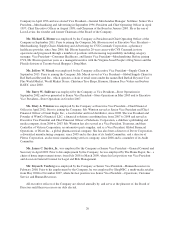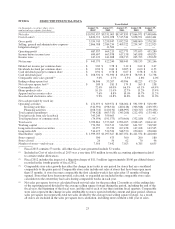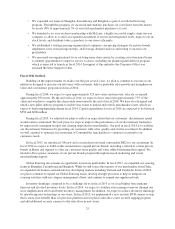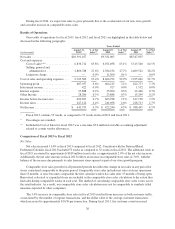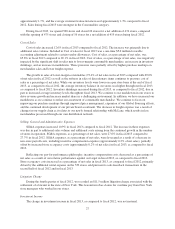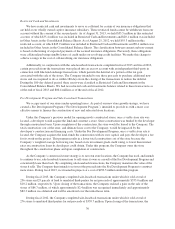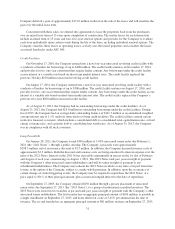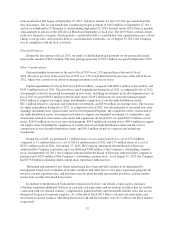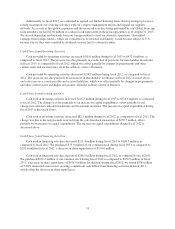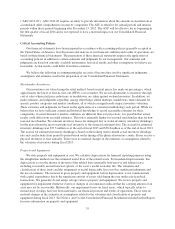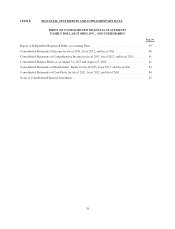Family Dollar 2013 Annual Report Download - page 34
Download and view the complete annual report
Please find page 34 of the 2013 Family Dollar annual report below. You can navigate through the pages in the report by either clicking on the pages listed below, or by using the keyword search tool below to find specific information within the annual report.Restricted Cash and Investments
We have restricted cash and investments to serve as collateral for certain of our insurance obligations that
are held at our wholly owned captive insurance subsidiary. These restricted funds cannot be withdrawn from our
account without the consent of the secured party. As of August 31, 2013, we held $55.5 million in this restricted
account, of which $35.4 million was included in Restricted Cash and Investments and $20.1 million was included
in Other Assets in the Consolidated Balance Sheets. As of August 25, 2012, we held $55.3 million in this
restricted account, of which $45.9 million was included in Restricted Cash and Investments and $9.4 million was
included in Other Assets in the Consolidated Balance Sheets. The classification between current and non-current
is based on the timing of expected payments of the secured insurance obligations. Previously, these obligations
were collateralized using standby letters of credit under our revolving credit facilities. We made this change to
achieve savings in the cost of collateralizing our insurance obligations.
Additionally, in conjunction with the sale-leaseback transactions completed in fiscal 2013 and fiscal 2012,
certain proceeds from the transactions were placed into an escrow account with an independent third-party in
connection with like-kind exchange transactions, which permits the deferral of a portion of the tax gain
associated with the sale of the stores. The Company intended to use these proceeds to purchase additional new
stores and was required to do so within 180 days from the closing of the transactions to realize the deferral.
During the 180-day deferral period, these assets were classified as Restricted Cash and Investments in the
Consolidated Balance Sheets. We had no restricted cash and investments balance related to these transactions as
of the end of fiscal 2013 and $80.4 million as of the end of fiscal 2012.
Fee Development Program and Sale-Leaseback Transactions
We occupy most of our stores under operating leases. As part of our new store growth strategy, we have
created a Fee Development Program (“Fee Development Program”), intended to provide us with a more cost
effective means to finance the construction of new and relocated store locations.
Under the Company’s previous model for opening newly constructed stores, once a viable store site was
located, a developer would acquire the land and construct a store. Store construction was funded by the developer
through construction loans. Upon completion of the construction, the store would be leased to the Company. The
total construction cost of the store, and ultimate lease cost to the Company, would be impacted by the
developer’s construction and financing costs. Under the Fee Development Program, once a viable store site is
located, the Company acquires the land, funds the construction with its own capital, and pays the developer a fee
for its work on the project. This program results in a lower total construction cost of the store because the
Company’s weighted average borrowing rate, based on its investment grade credit rating, is lower than interest
rates on construction loans its developers could obtain. Under this program, the Company owns the store
throughout the construction phase and upon completion of construction.
As the Company’s current real estate strategy is to not own store locations, the Company has used, and intends
to continue to use, sale-leaseback transactions to sell stores it owns as a result of the Fee Development Program and
concurrently lease them back. By completing sale-leaseback transactions, the Company monetizes the value of the
stores it sells. The Company then intends to re-invest the proceeds into the Fee Development Program to construct
more stores. During fiscal 2013, we invested in projects at a cost of $292.5 million under this program.
During fiscal 2013, the Company completed sale-leaseback transactions under which it sold a total of
256 stores and 29 parcels of land to unrelated third-parties for net proceeds of approximately $335.0 million and
$10.2 million, respectively. Upon closing of the transactions, the Company realized a gain on the sale of the
stores of $84.7 million, of which approximately $2.4 million was recognized immediately and approximately
$82.3 million was deferred and will be amortized over the initial lease term.
During fiscal 2012, the Company completed sale-leaseback transactions under which it sold a total of
276 stores to unrelated third-parties for net proceeds of $359.7 million. Upon closing of the transactions, the
30


